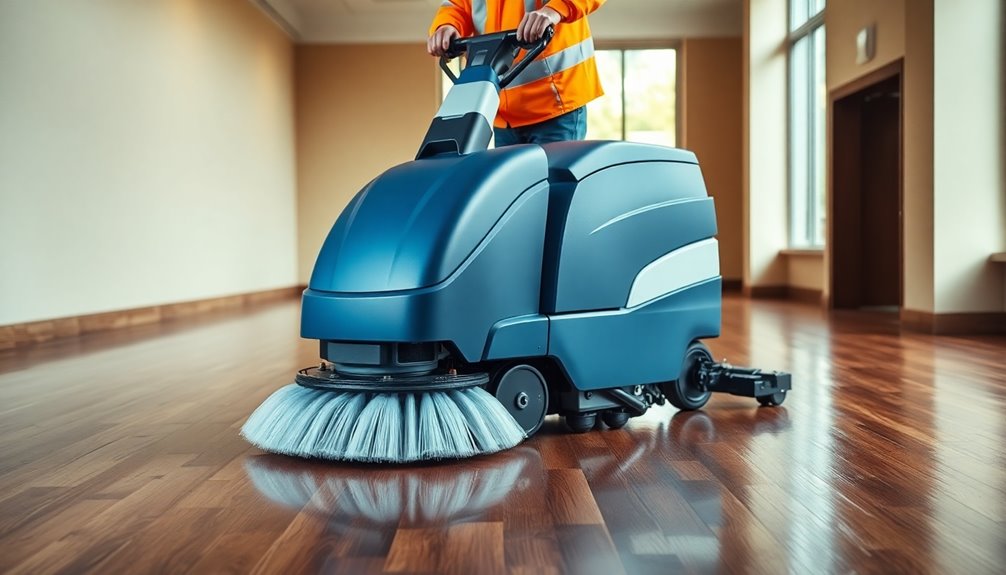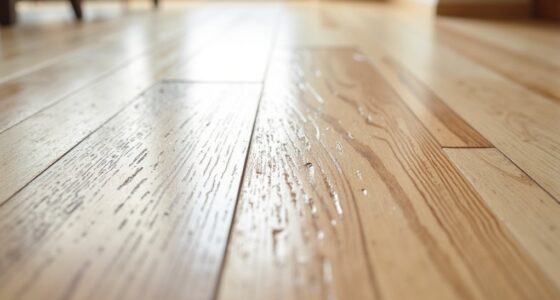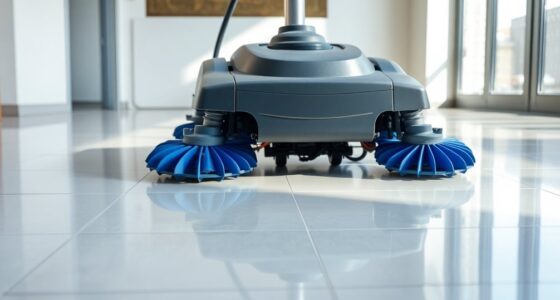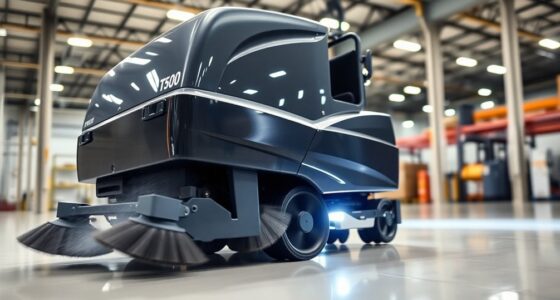To use a walk-behind floor scrubber, start by clearing the area and pre-treating any stubborn stains. Adjust the brush pressure and water flow based on your floor type. Begin scrubbing from the corner farthest away from your exit, making straight, overlapping passes. Monitor the recovery tank and empty it as needed to maintain a clean solution. Finally, rinse the tanks and brushes after use to ensure efficiency. Keep on going to discover more effective cleaning tips!
Key Takeaways
- Clear the area of obstacles and pre-treat any spills to prepare for efficient cleaning.
- Start scrubbing from the corner farthest from the exit using straight, overlapping passes.
- Monitor the recovery tank level and empty it as needed to avoid redistributing dirty water.
- Rinse and empty both recovery and solution tanks after use to prevent residue build-up.
- Regularly check and maintain equipment for optimal performance and cleaning results.
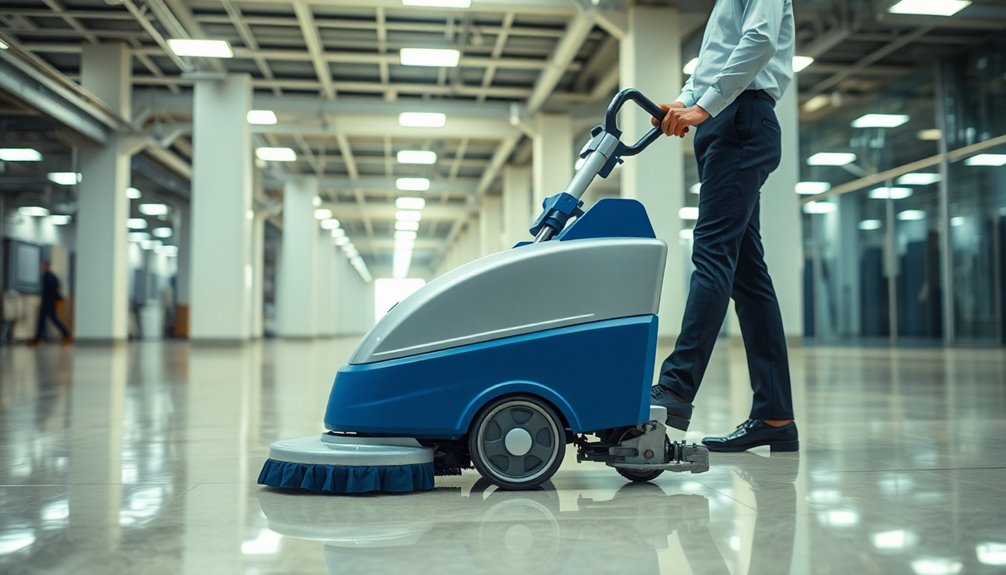
Using a walk-behind floor scrubber can transform your cleaning routine, making it faster and more effective. To get started, you'll want to clear the area of any obstacles and pre-treat any spills or stubborn stains. This preparation ensures a safe and efficient cleaning process.
Once the area is ready, fill the solution tank with the appropriate cleaning solution based on the manufacturer's recommendations. It's important to adjust the brush pressure and water flow according to the type of floor you're cleaning to achieve optimal results.
When you begin scrubbing the floor, start from the corner furthest from the exit. This method prevents you from walking over the freshly cleaned areas, which could reintroduce dirt. Use straight lines and slightly overlapping passes to avoid missing any spots and maintain a consistent pace. This technique helps in achieving thorough and effective cleaning, especially in commercial cleaning environments where time and efficiency matter.
As you operate the walk-behind floor scrubber, keep an eye on the recovery tank level. It's crucial to empty the recovery tank as needed. If the tank fills up, dirty water can get redistributed back onto the floor, undoing all your hard work. Regular monitoring ensures that you're always working with a clean solution, contributing to the overall effectiveness of your scrubbing.
After you've finished scrubbing the floor, make sure to follow essential maintenance procedures. Thoroughly rinse and empty both the recovery and solution tanks to prevent any residue build-up. Clean the brushes and squeegee to maintain the equipment's efficiency.
It's also a good idea to check for any loose or damaged parts during this time. Keeping your walk-behind floor scrubber in top condition will maximize its lifespan and performance.
Incorporating these steps into your cleaning routine won't only enhance your cleaning efficiency but also ensure that your walk-behind floor scrubber operates at peak performance. With regular maintenance and proper usage, you'll achieve optimal cleaning results, making your cleaning tasks easier and more manageable.
Frequently Asked Questions
How Do You Use a Floor Scrubber Ride?
To use a floor scrubber ride, start by setting it up with the right cleaning solution and ensuring everything's secure.
Power it on and begin at the farthest corner, moving in slow, wide turns. Adjust the settings based on the floor type and soil level.
For tough spots, scrub twice for a deeper clean.
After you're done, empty and rinse the tanks, clean the squeegee, and fully charge the batteries for the next use.
Is Scrubbing Better Than Mopping?
Imagine a shimmering floor, reflecting the light like a polished gem.
Scrubbing is definitely better than mopping. It digs deep into grime, leaving surfaces spotless and fresh. You'll find it saves time, cutting down on multiple passes and drying periods.
Plus, with separate tanks for clean and dirty water, you're minimizing cross-contamination.
How to Fill Floor Scrubber With Water?
To fill your floor scrubber with water, start by ensuring the solution tank's clean and free from residue.
Next, fill it with clean water, stopping at the maximum fill line recommended by the manufacturer.
After that, add the right amount of cleaning solution based on the water volume you've used.
Finally, securely close the tank lid to avoid spills and check for any leaks before you begin cleaning.
How Do Floor Scrubbers Work?
Floor scrubbers work by dispensing a cleaning solution onto the floor.
You'll notice rotating brushes or pads agitating the dirt, making it easier to clean.
The machine's recovery system vacuums up the dirty solution and debris, leaving the floor spotless and dry in one go.
Conclusion
Using a walk-behind floor scrubber can transform your cleaning routine, making it efficient and effective. Imagine a busy restaurant where the floors are constantly stained with spills. With the scrubber, you glide through the dining area, leaving behind a sparkling clean surface that enhances the atmosphere for customers. In just minutes, you tackle what used to take hours, ensuring your staff can focus on serving instead of cleaning. You'll feel a sense of accomplishment with every sweep!
